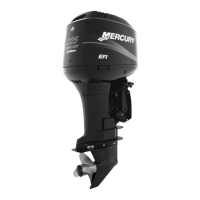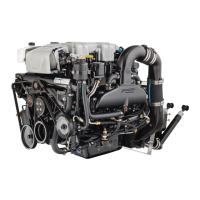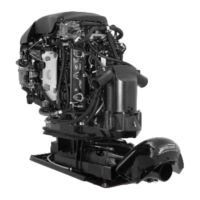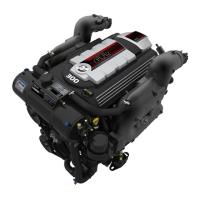FUEL INJECTION
90-883728 JULY 2001 Page 3B-15
EFI Electrical Components
ELECTRONIC CONTROL MODULE (ECM)
The ECM is continually monitoring various engine conditions (engine temperature, engine
detonation control (Model 200 only), engine throttle opening and climate conditions (induc-
tion air temperature, barometric pressure and altitude level) needed to calculate fuel deliv-
ery (pulse width length) of injectors. The pulse width is constantly adjusted (rich/lean con-
ditions) to compensate for operating conditions, such as cranking, cold starting, climate
conditions, altitude, acceleration and deceleration, allowing the outboard to operate effi-
ciently at all engine speeds.
12 Volt Battery - The 12 volt battery provides power to the ECM through the main power
relay.
IMPORTANT: When disassembling EFI System DISCONNECT BATTERY CABLES.
In the “start” position, injector pulse widths are increased as engine head temperature is
reduced to provide adequate fuel for quick start up.
Fuel Injectors - A 12 wire harness connects the fuel injectors to the ECM. The red wire
is at 12 volts and connects to all injectors. The BLUE, YELLOW, WHITE, BROWN, PUR-
PLE and ORANGE wires each go to individual injectors and are normally at 12 volts for
a zero differential. To fire the injectors this voltage is brought down to near ground creating
a potential across the injectors.
Electric Fuel Pump - The ECM contains a fuel pump driver circuit that provides power to
the electric fuel pump. The fuel pump does not have its negative terminal (–) “BLACK/RED
wire” grounded to the pump housing. The fuel pump positive terminal (+) “RED wire” and
the negative terminal (–) are at 12 volts with the ignition switch in the off position for a zero
differential. When the pump is on, the negative terminal is brought down to near ground
(i.e. 1.5 volts).
SENSOR INTERACTION WITH THE ECM
IMPORTANT: DO NOT run engine for extended periods of time with sensors discon-
nected or bypassed (shorted). Serious engine damage may result.
AIR TEMPERATURE SENSOR
The air temperature sensor transmits manifold absolute air temperature, through full RPM
range, to the ECM. As air temperature increases “sensor” resistance decreases causing
the ECM to decrease fuel flow (leaner mixture). Disconnecting the air temperature sensor
or temperature sensor failure will cause the ECM to revert to a default temperature source
of 32° F (0° C).
MANIFOLD ABSOLUTE PRESSURE (MAP) SENSOR
The map sensor is a non-serviceable sensor mounted on top of the air plenum. The MAP
sensor is used to sense changes in manifold absolute pressure. The MAP sensor is func-
tioning through the full RPM range and is continually signaling induction manifold pressure
readings to the ECM. The ECM in turn determines fuel flow as signals are received. The
MAP sensor’s operation can be monitored using the DDT. With the engine running, as the
throttle is increased or decreased, the MAP sensor’s DDT display should change. If no
change occurs, MAP sensor is not functioning properly.
